Far field microphone and near field microphone
The near field microphone and far field microphone are very important microphone array parts in the smart speakers , the voice interaction is a trend in the future for smart home and other smart applications, the microphone dominates the quality of voice recognition rate, because it determines the sensitivity of receiving voice, and now the near field and far field are words to descript the microphone situation.
Some clients often ask what is the far field microphone , and what is the near field of the microphone inside our Amazon alexa enabled smart wifi speaker, here is the total way to distinguish the far field or near field in Shiningintl smart speaker.

the difference between far field and near field
The problem of sound source location recognition based on microphone array is different from the traditional narrow-band Direction of arrivals problem in the following aspects:
- A) The difference between a stable signal and a short-term stable signal : the traditional microphone array can get stable signal in a related long time interval to retrieve accurate signal function, but when receiving short time stable signal, when the signal interval is longer than 40ms, it is not stable any more, the accuracy is low in the normal algorithm, it need a new algorithm to get more accurate voice receiving.
In the time domain it is difficult to obtain accurate correlation function. This leads to the performance degradation of conventional array processing algorithms.
- B) According to the distance between the sound source and the microphone array, the acoustic field models can be divided into two types: the near-field model and the far-field model. The near-field model regards the sound wave as a spherical wave, which takes into account the amplitude difference between the received signals of the microphone array element. The far-field model regards the sound wave as a plane wave, ignoring the amplitude difference between received signals of each array element, only think those are only time delay relationship. Obviously far-field model is the simplification of the real model, which greatly simplifies the processing difficulty. The general method of speech enhancement is based on the far-field model.
The difference between the near-field and the far-field: In the far-field case, the array waves can be considered as a simple plane wave. The direction each signal arrived at each array element is at the same, and the difference between the received signal amplitude in each array element is ignored. However, in the near-field case, the array waves should adopt the spherical wave model, and the signal arrives at each array element in different directions and amplitudes. Therefore, near-field array processing to consider the amplitude attenuation and phase shift
Based on the description above, we have learned the difference between the far field and near field, but how can I know what distance is far field, and what distance called near field?
In Shiningintl smart near and fare field microphone, we simple this distance calculation based on the function.
Empirical formula: R is the distance between the source and the microphone array, L is the total spacing of the uniform linear array of ULA (n * d)
r <2L * L / lamda, lamda said wavelength; calculated, S on behalf of the right result, S1 = 2 × 0.32 × 0.32 / 0.1 = 2.048 m
That is to say. For the Shiningintl SA-59 smart speaker,
When R> 2.048 meters, it is in the far field (array element is five, 4 × 0.08m = 0.32m);
When R <2.048 m, it is near field (array element is five, 4 × 0.08m = 0.32m);
normally in Shiningintl , we often categories the smart near field micprophone below 5 meters, and the far field microphone is longer than 5 meters.

